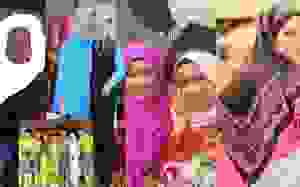Sabah S Kadazandusun Heritage Bearers And Nation Builders
HISTORY | The Kadazandusun (also spelt Kadazan-Dusun) are the largest ethnic group in Sabah (formerly North Borneo), Malaysia.
The term “Kadazandusun” was officially adopted to unify two closely related groups: the Kadazan, who traditionally inhabited the coastal and lowland areas of western Sabah, and the Dusun, who predominantly resided in the interior and highland regions.
Despite geographical differences, both groups share closely related Austronesian languages, cultural practices, and ancestral roots.
According to the Kadazan Dusun Cultural Association (KDCA), Sabah, there are 48 dialectal and tribal groups officially recognised under the Kadazandusun umbrella.
Renowned for their vibrant cultural heritage, the Kadazandusun people have played a central role in shaping Sabah’s vibrant multicultural identity.
Origins and early history
According to oral tradition, the Kadazandusun trace their ancestral origins to Nunuk Ragang – the “Red Banyan Tree” settlement located near Tampias in the Ranau district, featuring a giant banyan tree under which the earliest longhouse community is said to have arisen.
Anthropological and linguistic evidence supports the view that the Kadazandusun descended from Austronesian-speaking seafarers and farmers who migrated from Taiwan through the Philippines into Borneo around 4,000–5,000 years ago.
These early migrants introduced rice cultivation, boat-building, and complex social structures to northern Borneo. Over millennia, they forged enduring settlements in both Sabah’s interior highlands and coastal lowlands, laying the foundations for Kadazandusun society today.

Early settlement and growth
The Kadazandusun were traditionally subsistence farmers, hunters, and gatherers of forest produce who practised swidden (slash-and-burn) hill paddy cultivation.
Some communities, particularly in the interior regions, lived communally in longhouses. In contrast, coastal Kadazans in areas such as Penampang and Papar typically resided in detached houses clustered into villages.
Over time, especially in the western lowlands and valleys, many communities adopted wet rice cultivation, leading to more sedentary lifestyles and the establishment of permanent villages.
Historically, Kadazandusun settlements have been concentrated in areas such as Penampang, Tambunan, Ranau, and Keningau.
In the 20th century, internal migration within these regions intensified as communities sought additional agricultural land and adapted to socioeconomic changes.
During the colonial era, Sabah attracted attention for its economic potential. From 1882 to 1941, Sabah was administered by the British North Borneo Company (BNBC).
During the Japanese occupation (1942–45), the region faced economic and social disruptions before being formally handed over to the British government in 1946 and designated a crown colony.
Under the BNBC and subsequent British colonial administration, basic infrastructure, mission schools, and a rudimentary civil service were introduced.
Kadazandusun youths were among the early beneficiaries of Western education provided by these mission schools, which served as a seeding ground for grooming the emerging Kadazandusun elite, including teachers, civil servants, and political leaders.
The population of Kadazandusun increased from about 90,000 in 1911 to 183,574 in 1970. Today, they number approximately 715,000, constituting about 20 percent of Sabah’s population.
While many still reside in districts such as Penampang, Papar, Ranau, Tambunan and Keningau, urban migration has also led to the formation of sizeable Kadazandusun communities in cities like Kota Kinabalu.
Occupations
Traditionally, the Kadazandusun were subsistence farmers, with agriculture forming the core of their livelihood. In lowland areas, they practised wet paddy cultivation, which became the economic backbone of many Kadazan communities.
In the interior highlands – such as Tambunan, Ranau, and Keningau – Dusun groups engaged in shifting cultivation, growing hill rice, maize, tapioca, and vegetables.
These farming activities were supported by livestock rearing, fishing, and forest foraging. The water buffalo was highly valued – not only for ploughing but also for its role in dowries, rituals, and communal feasts.
Since the mid-20th century, particularly with educational reforms and rural development, many Kadazandusun have ventured into diversified occupations such as the public service, education, business, and professions like law, medicine, and engineering.
While farming remains part of village life, the community today is increasingly integrated into Malaysia’s non-agricultural economy.
Language and identity

PenampangThe Kadazandusun language, which belongs to the Dusunic branch of the Austronesian language family, comprises numerous dialects.
Among the most prominent are Kadazan, spoken in areas such as Penampang, Papar, and Putatan, and Bundu Dusun, spoken in districts like Ranau, Tambunan, and Keningau.
Despite these dialectal differences, the language shares a common linguistic foundation that reflects the community’s shared heritage.
Language plays a crucial role in preserving the community’s cultural identity. In recent decades, the Kadazandusun language has seen a decline in everyday use due to the dominance of Malay and English in education and administration.
However, strenuous revitalisation efforts are underway. The language is now taught in some schools, and Radio Televisyen Malaysia broadcasts in Kadazandusun, helping to contribute towards efforts to preserve it for future generations.
Customs and traditions
Kadazandusun society is built on communal values, reciprocal labour, and close kinship ties. Cultural norms emphasise respect for elders, hospitality, and harmony with nature.
Marriage is regarded as both a social and spiritual union, often solemnised with traditional music, dance, and sacrificial rituals.
Kaamatan, the Harvest Festival celebrated annually in May, is the most iconic and defining cultural event of the Kadazandusun community.

The Sumazau danceRooted in ancient beliefs, it honours Bambarayon (or Bambaazon), the rice spirit, through traditional rituals, the Sumazau dance, and communal feasting.
Central to the celebration is the Unduk Ngadau beauty pageant, a cultural highlight that commemorates the legendary Huminodun – a maiden who, according to Kadazandusun mythology, selflessly sacrificed herself to restore life and ensure a bountiful harvest.
Beyond its festive and social celebrations, Kaamatan serves as a profound expression of gratitude, cultural identity, and community unity.

Contestants at a Unduk Ngadau beauty pageantReligion and spiritual practices
The Kadazandusun traditionally adhered to an animistic belief system deeply intertwined with nature and agriculture.
Central to their cosmology was Kinorohingan, the supreme creator deity, accompanied by numerous susukuon – nature spirits believed to inhabit rivers, forests, mountains, and other natural elements.
These spirits were venerated and ritually appeased to ensure harmony and avert calamities. Rituals were officiated by the bobohizan (Kadazan) or bobolian (Dusun) - a revered priestess who functioned as a spiritual guide, healer, and guardian of sacred knowledge and ancestral traditions.
With the arrival of Christian missionaries in the late 19th and early 20th centuries, a significant portion of the Kadazandusun population embraced Christianity.
Today, Christianity – particularly Roman Catholicism and Anglicanism – is the dominant faith among the Kadazandusun. A minority, estimated at approximately 10 to 15 percent, have converted to Islam.
The Kaamatan cultural festivalNonetheless, vestiges of traditional Kadazandusun spiritual practices continue to coexist with their adopted religions, particularly evident during cultural festivals such as Kaamatan and significant life-cycle ceremonies.
Traditional attire
The traditional attire of the Kadazandusun is both functional and richly symbolic, reflecting regional variations, social status, and deep cultural heritage.
For women, the most iconic outfit is the sinuangga – a fitted black velvet blouse often embellished with ornate gold or silver buttons – paired with the tapi, a long black skirt featuring intricately embroidered edges.
These garments are complemented by elaborate accessories such as coin belts, multi-strand beaded necklaces, and brass bangles, which together signify beauty, craftsmanship, and social identity.
Men typically wear the gaung, a black long-sleeved jacket, along with the tangkong, a knee-length sarong tied at the waist. The ensemble is completed with a traditional headcloth, adding a dignified and ceremonial touch.
These traditional garments are worn with pride during the annual Kaamatan and other cultural celebrations, serving as powerful symbols of ethnic pride, ancestral continuity, and cultural resilience.

A Kadazan Penampang couple dressed in traditional attireCuisine
The Kadazandusun cuisine is closely linked to the natural environment and seasonal produce. Staple foods include rice, sweet potatoes, and tapioca. Dishes often incorporate wild vegetables, freshwater fish, and game meat.
Notable traditional dishes include hinava (raw fish salad marinated in lime juice, ginger, shallots, chilli and bitter gourd), noonsom (fermented dish made from bambangan fruit or fish), and pinasakan (braised fish with sour fruit like takob-akob).
Fermented rice wine, known as lihing or tapai, is an essential part of festive gatherings and rituals.
Main associations and political parties
The Society of Kadazan was formed in 1953 at Penampang to promote native culture and rights. It evolved into the Kadazan Cultural Association in 1963, and in 1991 was renamed the Kadazan Dusun Cultural Association (KDCA) Sabah.
The first political party in Sabah was the United National Kadazan Organisation (Unko) which was established in August 1961 and led by Donald Stephens. He later led the merger with the United Pasok Momogun Kadazan Organisation (Upko) in June 1964.
Other prominent parties that have emerged since to promote the political and cultural interests of the Kadazandusun include the Parti Bersatu Sabah (PBS) and the Parti Solidariti Tanah Airku (Sabah Star).

Contributions to nation-building
The Kadazandusun community has played a pivotal role in the political, educational, and socio-economic development of Sabah, while also contributing significantly to Malaysian nation-building.
As one of the earliest indigenous groups to embrace formal education – particularly through mission schools established during the British colonial era – they produced a generation of teachers, civil servants, professionals, and political leaders who were instrumental in shaping Sabah’s development and progress.
The Kadazandusun have also been deeply involved in political advocacy through the formation of indigenous-based political parties, such as Unko, Upko, and later PBS and Sabah Star.
These parties have vigorously and constantly championed issues related to land rights, native customary laws, cultural preservation, and religious freedom, which are central to the community.
The Kadazandusun have strived assiduously to balance economic advancement and modernisation with the preservation of their indigenous values, thereby contributing to a more inclusive and multicultural Malaysian society.
Their active participation in nation-building has helped ensure that Sabah’s indigenous voices remain integral to Malaysia’s political and cultural landscape.
Prominent leaders
Among the most influential Kadazandusun leaders was the late Fuad Stephens (formerly Donald Stephens), who served as Sabah’s first chief minister (September 1963–December 1964), third governor (September 1973–July 1975), and later as fifth chief minister (April–June 1976).
As the first Huguan Siou (paramount leader) of the Kadazandusun community, he played a major role in raising political awareness and mobilisation of the Kadazandusun and Sabahans generally.

Fuad Stephens, Sabah’s first chief ministerHe was instrumental in forging Sabah’s integration into the Federation of Malaysia. Stephens’ leadership and vision left an indelible mark on the state’s history.
Tragically, he died in a plane crash in Kota Kinabalu on June 6, 1976, an incident widely referred to as the “Double Six Crash”.
Another towering Kadazandusun figure in Sabah’s political landscape is Joseph Pairin Kitingan, Sabah’s seventh chief minister (April 1985–March 1994), and the founder of the PBS in March 1985.
As Huguan Siou, he remains a greatly revered figure within the Kadazandusun community. Pairin also led efforts to expand the KDCA with branches in each locality.
The late Peter Joinod Mojuntin, hailed as the “Golden Son of the Kadazan” was a passionate advocate for native rights and cultural preservation, playing a critical role in articulating the “20 Points” governing Sabah’s entry into Malaysia.
He served as the state housing and local government minister before his untimely death in the 1976 “Double Six Crash”. He also served as the secretary of Upko and the first chairperson of the Sabah Pastoral Council.

Peter Joinod Mojuntin, a former Sabah ministerJeffrey Kitingan, the younger brother of Pairin, has long been an influential political figure in Sabah. In 2016, he founded Sabah Star.
A fearless and staunch advocate for Sabah’s rights within the Malaysian federation, he champions the vision of Sabah as an equal partner alongside Malaya and Sarawak – an idea encapsulated in the slogan “Sabah for Sabahans”.
He has held various leadership positions, including serving as deputy chief minister I since Jan 11, 2023.
Jeffrey has long been a vocal critic of the federal government’s controversial “Project IC” – an alleged covert operation primarily carried out in the 1980s and 1990s.

Jeffrey Kitingan founded the Sabah chapter of Parti Solidariti Tanah AirkuAccording to critics, the operation was aimed at systematically granting Malaysian citizenship and identity cards to immigrants – mainly from the Philippines, Indonesia and Pakistan – in order to manipulate the electoral roll in favour of certain political parties.
It is further alleged that the underlying motive was to alter the demographic composition of Sabah by increasing the Muslim population to serve political interests.
In 2012, former Sabah state assemblyperson and senator Chong Eng Leong claimed that there were approximately 700,000 “Project IC citizens” in Sabah, with around 200,000 reportedly registered as voters on the state’s electoral roll.
Significantly, Sabah’s population increased by nearly fourfold between 1970 and 2000 – from about 650,000 to approximately 2.5 million – raising serious concerns about irregular naturalisation and its impact on the state’s demographic and political landscape.
Other distinguished leaders include the late James P Ongkili who served as Sabah deputy chief minister (July 1976–December 1981); and Bernard Dompok who served briefly as the 11th Sabah chief minister (May 1998–March 1999), minister in the Prime Minister’s Department (December 1999–April 2009), and plantation industries and commodities minister (April 2009–May 2013).
In academia, the late Ongkili was a distinguished scholar in the field of Malaysian nationalism, while Professor Felix Tongkul is widely recognised for his contributions to geophysics and natural disaster risk management.

The late James Peter Ongkili, a former Sabah deputy chief ministerChallenges and the way forward
Despite their accomplishments, the Kadazandusun community faces several pressing challenges. Language attrition remains a major concern, especially among the younger generation.
Urban migration and intermarriage have diluted cultural practices, while serious economic inequalities persist in rural areas where many Kadazandusun still reside.
Land rights, particularly those related to native customary rights (NCR), remain a contentious issue for the community. Encroachment by commercial plantations and limited legal recognition of ancestral lands threaten traditional livelihoods and identity.
Addressing these challenges requires sustained investment in continued political, social, and cultural mobilisation; expanded access to higher education; accelerated economic development; legal reforms; community-based initiatives; and parallel efforts to preserve the community’s cherished cultural heritage.
Equally vital are leveraging digital media to preserve the language and empowering youth through inclusive policies, both of which are crucial to ensuring the community’s cultural and economic resilience.
Conclusion
The Kadazandusun people stand as a proud testament to the cultural resilience, rights, and community spirit of one of Sabah’s core ethnic groups. Their ancestral wisdom, spiritual traditions, and modern contributions continue to shape the identity and progress of the state.
As they confront the pressures of modernisation, preserving their cultural and political rights, language, heritage, and communal bonds is imperative.
With sustained advocacy, education, and unity, the Kadazandusun can confidently chart a path forward – one that honours their past while building a vibrant and inclusive future within Malaysia’s multicultural tapestry. - Mkini
RANJIT SINGH MALHI is an independent historian who has written 19 books on Malaysian, Asian and world history. He is highly committed to writing an inclusive and truthful history of Malaysia based upon authoritative sources.
The views expressed here are those of the author/contributor and do not necessarily represent the views of MMKtT.
Artikel ini hanyalah simpanan cache dari url asal penulis yang berkebarangkalian sudah terlalu lama atau sudah dibuang :
http://malaysiansmustknowthetruth.blogspot.com/2025/06/sabahs-kadazandusun-heritage-bearers.html
 PING BABAB : Raksasa Aggregator Malaysia
PING BABAB : Raksasa Aggregator Malaysia
 Early settlement and growth
Early settlement and growth PenampangThe Kadazandusun language, which belongs to the Dusunic branch of the Austronesian language family, comprises numerous dialects.
PenampangThe Kadazandusun language, which belongs to the Dusunic branch of the Austronesian language family, comprises numerous dialects. The Sumazau danceRooted in ancient beliefs, it honours Bambarayon (or Bambaazon), the rice spirit, through traditional rituals, the Sumazau dance, and communal feasting.
The Sumazau danceRooted in ancient beliefs, it honours Bambarayon (or Bambaazon), the rice spirit, through traditional rituals, the Sumazau dance, and communal feasting. Contestants at a Unduk Ngadau beauty pageantReligion and spiritual practices
Contestants at a Unduk Ngadau beauty pageantReligion and spiritual practices A Kadazan Penampang couple dressed in traditional attireCuisine
A Kadazan Penampang couple dressed in traditional attireCuisine Contributions to nation-building
Contributions to nation-building Fuad Stephens, Sabah’s first chief ministerHe was instrumental in forging Sabah’s integration into the Federation of Malaysia. Stephens’ leadership and vision left an indelible mark on the state’s history.
Fuad Stephens, Sabah’s first chief ministerHe was instrumental in forging Sabah’s integration into the Federation of Malaysia. Stephens’ leadership and vision left an indelible mark on the state’s history. Peter Joinod Mojuntin, a former Sabah ministerJeffrey Kitingan, the younger brother of Pairin, has long been an influential political figure in Sabah. In 2016, he founded Sabah Star.
Peter Joinod Mojuntin, a former Sabah ministerJeffrey Kitingan, the younger brother of Pairin, has long been an influential political figure in Sabah. In 2016, he founded Sabah Star. Jeffrey Kitingan founded the Sabah chapter of Parti Solidariti Tanah AirkuAccording to critics, the operation was aimed at systematically granting Malaysian citizenship and identity cards to immigrants – mainly from the Philippines, Indonesia and Pakistan – in order to manipulate the electoral roll in favour of certain political parties.
Jeffrey Kitingan founded the Sabah chapter of Parti Solidariti Tanah AirkuAccording to critics, the operation was aimed at systematically granting Malaysian citizenship and identity cards to immigrants – mainly from the Philippines, Indonesia and Pakistan – in order to manipulate the electoral roll in favour of certain political parties. The late James Peter Ongkili, a former Sabah deputy chief ministerChallenges and the way forward
The late James Peter Ongkili, a former Sabah deputy chief ministerChallenges and the way forward


























